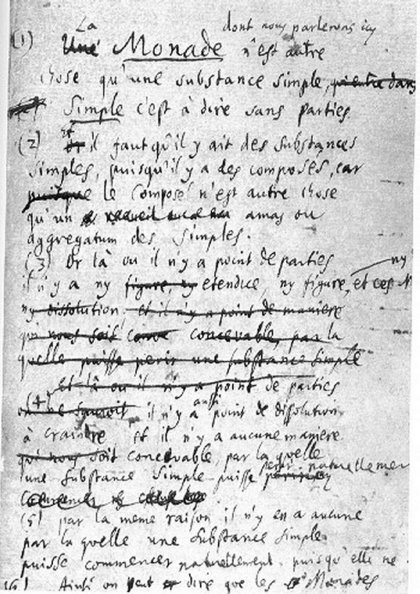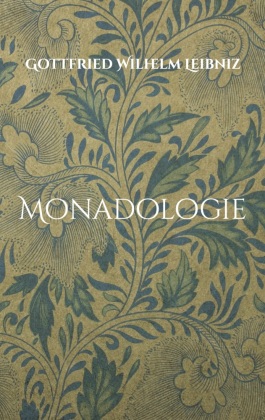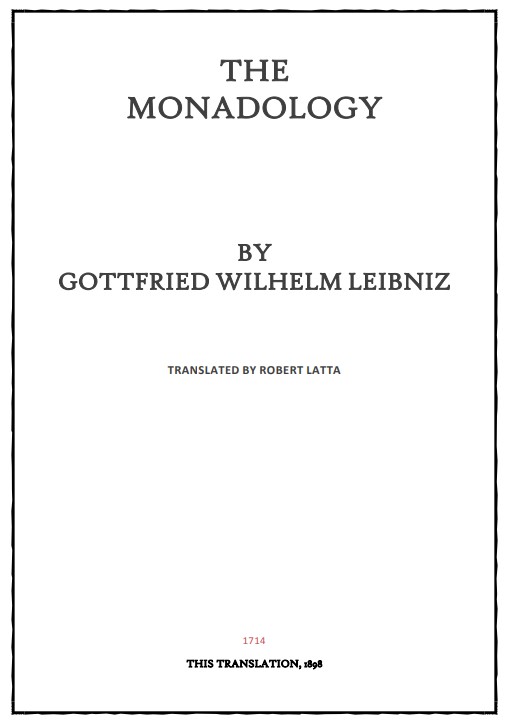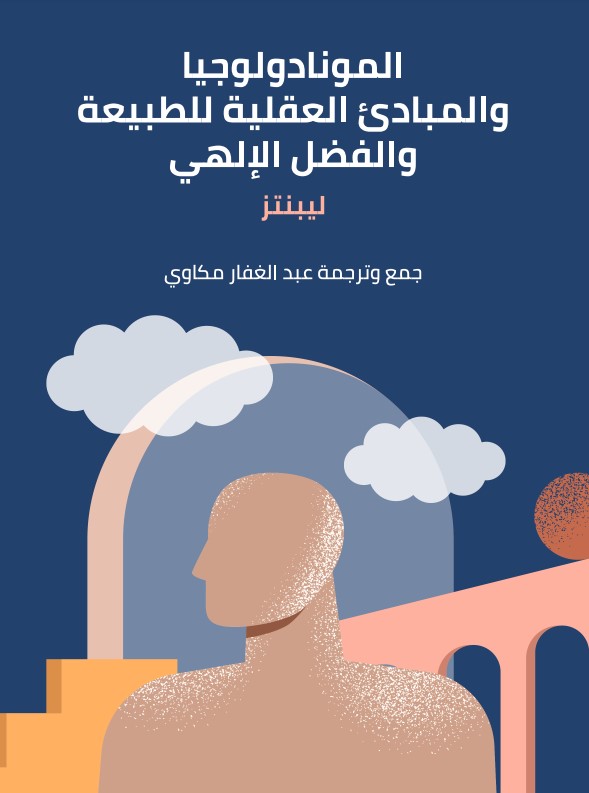La Monadologie
par
Gottfried Wilhelm Leibniz

La Monadologie, 1714, manuscrit
« Leibniz, philosophe et mathématicien, développe au XVIIIe siècle une pensée visionnaire de la complexité dans sa Théodicée – avec notamment son appréhension du mal évalué en termes d’optimisation combinatoire – et son éblouissant traité de Monadologie qui décline 90 propositions vitalistes sur le simple ; autant de points de vue, perspectives sur le complexe. Les relations tout-partie trouvent avec Leibniz et son souci du détail, de la manière et du pli une épistémologie véritablement alternative par rapport à la vision réductionniste et l’analyse classique. La monadologie permet de mieux comprendre comment plus on creuse, plus on s’enfonce en réalité, plus la matière est marquée par la multiplicité. La matière ne se découpe pas aussi bien qu’elle se plie, replie, remplit, déploie ses plis qui « vont à l’infini ». L’œuvre de Leibniz explicite les rapports entre le fragment (in)signifiant et l’ensemble (in)commensurable, que ce soit dans les sciences du vivant, de la matière et du calcul. »
R. Benkirane, La Complexité, vertiges et promesses. Histoires de sciences, UM6P-Press, 2023.
« Leibniz est un isthme (barzakh) entre les sciences traditionnelles (ayant de tout temps exprimé la complexité en figures et en paraboles) et les sciences exactes (qui la décrivent en langage physico-mathématique). Il est l’homme qui manie à la fois la formule et l’équation, la science du nom et celle du nombre. »
R. Benkirane, Islam à la reconquête du sens, « Monadologie et coranologie: magnifi-science de l’univers», 2017, 2021.
…o0o…
The Monadology
“Leibniz, a philosopher and mathematician, developed a visionary concept of complexity in the 18th century in his Theodicy – with his understanding of evil as combinatorial optimization – and his dazzling treatise on Monadology, which contains 90 vitalist propositions about the monad; as many points of view, perspectives on complexity. The relationships between whole and part, as found in Leibniz’s attention to detail, manner, and fold, present an alternative epistemology when compared to the reductionist view and classical analysis. The Monadology helps us better understand how the deeper we delve, the more we plunge into reality, and the more matter is characterized by multiplicity. Matter does not so much cut as it folds, refolds, fills, and unfolds its folds which “reach to infinity”. Leibniz’s work explains the relationships between the (in)significant fragment and the (in)commensurable whole, be it in the life sciences, matter, and computation.
With his understanding of evil as combinatorial optimization, Leibniz, a philosopher and mathematician, developed a visionary concept of complexity in the 18th century in his Theodicy and his dazzling treatise on Monadology, which contains 90 vitalist propositions about simplicity.”
Reda Benkirane, Complexity, Vertigoes and Promises. Histories of Sciences, UM6P-Press, 2023.
“Leibniz is an isthmus (barzakh) between traditional sciences (which have always expressed complexity in figures and parables) and exact sciences (which describe it in physico-mathematical language). He is the man who handles both the formula and the equation, the science of the name and that of the number.”
Reda Benkirane, Islam in the Reconquest of Meaning, “Monadology and Quranology: Magnifi-science of the universe”, 2017, 2021.
المونادولوجيا
لايبنتس، الفيلسوف والرياضي، قام في القرن السابع عشر بتطوير تفكير رؤيوي حول التعقيد في كتابه “اللاهوتيات”، حيث قدم تقديرًا للشر بصورة تنظيمية محسوبة ومعالجة في مفهوم التحسين التوافقي، وألَّف أيضًا مؤلفًا رائعًا بعنوان “علم الأشياء البسيطة” الذي يحتوي على 90 اقتراحًا حيويًا حول الأمور البسيطة؛ وهذه كلها وجهات نظر وآفاق على التعقيد. يُظهر العلاقات الكل-الجزء نظرًا لاهتمام لايبنتس بالتفاصيل والأسلوب والطي في عرضه، منهجًا علميًا بديلًا تمامًا مقارنةً بالرؤية الاختزالية والتحليل الكلاسيكي. تساعد مونادولوجيته في فهم كيف يزيد الحفر أكثر، كيفما تعمقنا، كلما كانت المادة مميزة بالتعدد. المادة لا تقطع، بل تثني وتعكس وتملأ وتنشر طياتها التي “تذهب إلى اللانهاية”. يُوضح عمل لايبنتس العلاقات بين الجزء (غير المعنوي) والمجموع، سواء في علوم الكائنات الحية أو العلوم الفيزيائية والرياضية وعلم الحساب.
– ر. بنكيران، التعقيد، دوار ووعود. تاريخ العلوم، UM6P-Press، 2023.
“لايبنتس هو ارتباط (برزخ) بين العلوم التقليدية (التي عبَّرت منذ الأزل عن التعقيد بأشكال وأمثال) والعلوم الدقيقة (التي تصفها بلغة فيزيائية ورياضية). إنه الرجل الذي يتعامل مع الصيغة والمعادلة على حد سواء، علم اسم الشيء وعلم العدد.”
– ر. بنكيران، الإسلام في استعادة المعنى، “علم الأشياء البسيطة وعلم القرآن: المعرفة السامية للكون”، 2017، 2021.



